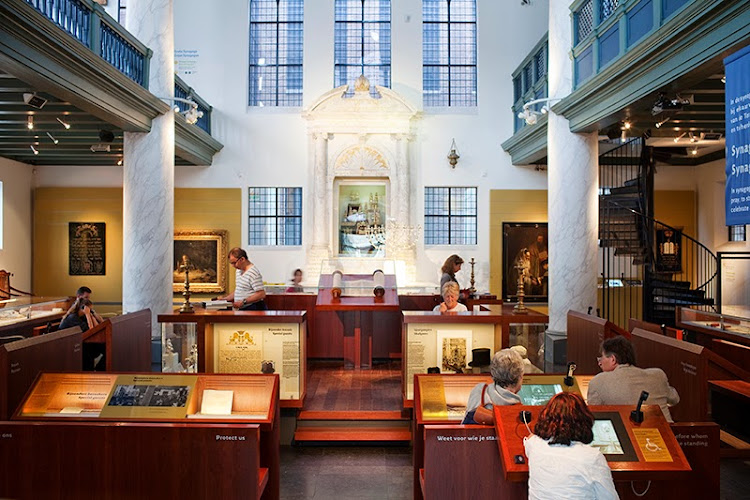Nestled along the Nieuwe Amstelstraat in Amsterdam’s historic Jewish Quarter, the Jewish Museum (Joods Museum) stands as a living testament to the rich tapestry of Jewish heritage and culture in the Netherlands.
Housed in a magnificent complex of four restored 17th and 18th-century Ashkenazi synagogues, this cultural landmark invites visitors to explore over 400 years of Dutch-Jewish history, from the arrival of Sephardic Jews in the Netherlands to present-day Jewish life. Here, you’ll discover fascinating stories, priceless artifacts, and interactive exhibits that bring Amsterdam’s Jewish heritage to life in ways that enlighten the mind and heart.
A Rich History of Jewish Life in the Netherlands
The Jewish community has been integral to Amsterdam’s identity since the late 16th century when Portuguese Jews fleeing persecution found refuge in this tolerant Dutch city.
By the 17th century, Amsterdam had become known as the “Jerusalem of the West,” with a thriving Jewish community contributing to the city’s Golden Age through art, scholarship, publishing, and trade.
The museum masterfully chronicles this journey, from periods of prosperity to the darkest chapters of the Holocaust when Nazi occupation led to the murder of over 75% of Dutch Jews. Through compelling exhibitions featuring historical artifacts, religious objects, and interactive displays, visitors gain profound insights into Jewish traditions, religious practices, and the community’s resilience throughout Dutch history.
“The synagogue complex itself tells a powerful story — these buildings survived World War II while the community they served was decimated. Today, they stand revitalized as spaces of remembrance, education, and celebration of Jewish culture.”
Why Visit: Beyond the Anne Frank House
While many travelers to Amsterdam prioritize the Anne Frank House, the Jewish Museum offers a more comprehensive understanding of Jewish life in the Netherlands. Here’s what makes it special:
- Remarkable Collection: The museum houses over 30,000 objects, artworks, photographs, and documents that bring to life Jewish cultural heritage. Don’t miss the spectacular Rintel Menorah from 1753, standing over a meter tall and made of intricately designed silver—one of Europe’s largest and most ornate ceremonial menorahs. The collection also includes rare 17th-century religious texts, historic synagogue ornaments, and compelling personal items that survived the Holocaust.
- Jewish Museum Junior: A dedicated children’s museum where young visitors aged 6-12 can explore Jewish traditions through interactive exhibits. Children can “bake” challah bread, write their names in Hebrew, and experience Jewish holidays through engaging activities. This award-winning space earned the Kidsproof Museum seal for 2024, recognizing its excellence in child-friendly education.
- Part of the Jewish Cultural Quarter: Your ticket includes admission to the Portuguese Synagogue, Holocaust Memorial, and National Holocaust Museum, allowing you to gain a deeper understanding of Jewish history in Amsterdam.
- Diverse Exhibitions: In addition to permanent displays, the museum hosts rotating exhibitions exploring contemporary Jewish art, culture, and social issues.
- Cultural Events: The museum regularly hosts concerts, lectures, and workshops celebrating Jewish cultural contributions.
Local Insights and Hidden Gems
The museum’s location in the heart of the former Jewish Quarter (Jodenbuurt) makes it an ideal starting point for exploring this historically significant neighborhood. After your visit:
- Take a short walk to explore Mr. Visserplein and see the striking Dockworker statue, which commemorates the February Strike of 1941 — when thousands of non-Jewish Dutch citizens protested Nazi persecution of Jews.
- Visit the Hollandsche Schouwburg (Dutch Theatre), once a vibrant performance venue transformed into a deportation center during World War II. Today, it serves as a profound memorial.
- Discover the Portuguese Synagogue nearby, a magnificent 17th-century building that still uses candlelight for illumination during special services.
- Wander along Jodenbreestraat, once the bustling center of Jewish commerce, where Rembrandt lived and worked among his Jewish neighbors.
Cycling There: The Amsterdam Way
Embracing Amsterdam’s cycling culture is the perfect way to reach the Jewish Museum. The city’s well-developed bike infrastructure makes this a sustainable and authentic travel choice:
From Central Station:
- Follow the main bike path east along Prins Hendrikkade
- Continue onto Nieuwe Herengracht
- Turn right onto Weesperstraat
- Look for the museum on your right after crossing the canal
- Total cycling time: Approximately 12 minutes (2.5 km)
From Dam Square:
- Head east on Damstraat
- Continue straight onto Oude Doelenstraat and Oude Hoogstraat
- Turn left onto Jodenbreestraat
- Turn right onto Nieuwe Amstelstraat
- Total cycling time: Approximately 8 minutes (1.8 km)
Bike Parking: Secure bike racks are in front of the museum entrance. As locals would advise, always use two locks when parking your bike in central Amsterdam.
Sustainable Tourism Tips
Support Amsterdam’s commitment to sustainable tourism with these eco-friendly approaches:
- Public Transport Alternative: If cycling isn’t your preference, take tram 14 to the Waterlooplein stop, just a 3-minute walk from the museum. This area is well-served by Amsterdam’s excellent public transportation network.
- Digital Tickets: Purchase your tickets online to reduce paper waste and enjoy a smoother entry.
- Combine Visits: Make the most of your cultural quarter ticket by visiting all four locations in one day, reducing your overall carbon footprint.
- Local Dining: After your visit, support sustainable local businesses like Café Kadosh, which serves kosher-style food with locally sourced ingredients.
Accessibility Information
The Jewish Museum Amsterdam is committed to being accessible to all visitors:
- Wheelchair Access: The museum is fully wheelchair accessible with ramps and elevators.
- Audio Guides: Available in multiple languages, including English, Dutch, German, French, and Spanish.
- Visual Aids: Large-print guides and braille materials are available upon request.
- Rest Areas: Several seating areas throughout the exhibition spaces allow visitors to rest during their tour.
Contact the museum in advance for specific accessibility requirements or to arrange special assistance.
Seasonal Considerations
The Jewish Museum offers a different experience depending on when you visit:
- Spring: Coincides with Passover and other Jewish spring festivals, often featuring special exhibitions and events.
- Summer: Peak tourist season means longer opening hours but more visitors. Early morning visits are recommended.
- Fall: Experience Jewish High Holidays (Rosh Hashanah and Yom Kippur) through special programming and exhibitions.
- Winter: The quietest time to visit, offering a more contemplative experience. During Hanukkah (usually in December), special candlelighting ceremonies may take place.
- Year-Round: The museum is open Tuesday through Sunday from 10am to 5pm, closed on Mondays and certain Jewish holidays.
A Bridge Between Past and Present
The Jewish Museum Amsterdam does more than preserve history—it builds bridges of understanding between cultures and generations. Its thoughtful curation and educational programs remind us how the Jewish community has been woven into the fabric of Dutch society for centuries.
Lock your bike, step inside, and discover one of Amsterdam’s most authentic cultural treasures—where centuries of heritage connect with the present through remarkable stories and treasures.

